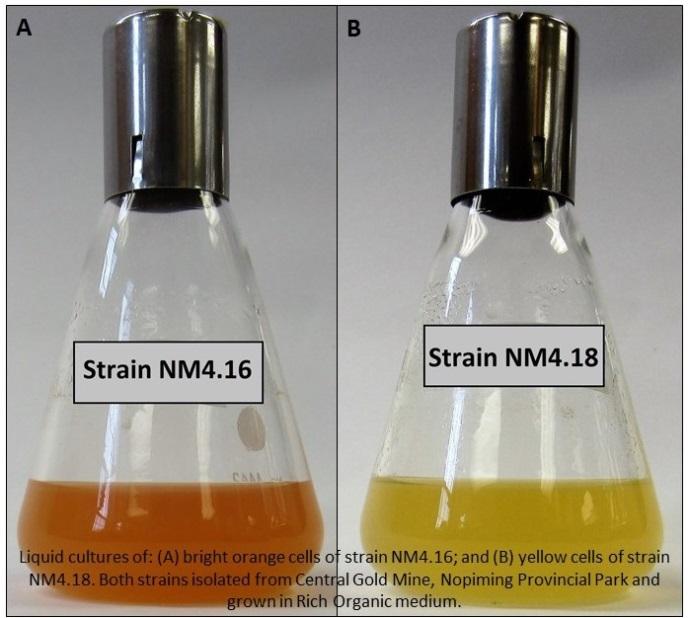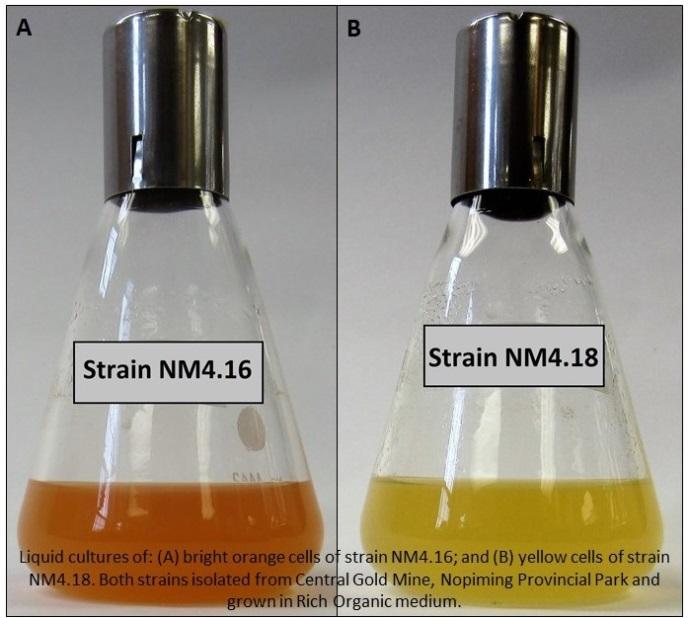
Credit: Dr. Vladimir Yurkov
A new study published in the Canadian Journal of Microbiology has identified new toxic metalloid-reducing bacteria in highly polluted abandoned gold mine tailings in Manitoba's Nopiming Provincial Park. "These bacteria have the ability to convert toxic components that exist as a result of mining activities into less toxic forms and are prevalent in extreme environments," says Dr. Vladimir Yurkov, Professor at the University of Manitoba. These bacteria or their enzymes may be potential candidates for the development of bioremediation technologies, a treatment that uses naturally occurring organisms to break down toxic substances. "We wanted to look at the bacterial resistance to toxic waste, which would be an important asset within the context of heavily polluted mines. We also aimed to enrich our understanding of the microbial diversity of extreme environments, knowing that the vast majority of these microbes and their potential uses and benefits, remain undiscovered," continued Dr. Yurkov.
Aerobic anoxygenic phototrophs (AAPs) are a physiological group of bacteria that have been found in many different environments, including harsh or extreme environments. Habitats with extremely high concentrations of metalloid oxides are toxic, but AAPs are able to survive in these locales. They do so by converting the toxic compounds to less toxic forms through a process called reduction. Microbes capable of removing toxic compounds from their environment are potentially beneficial for bioremediation, the use of bacteria to clean up contaminated environments. By identifying bacteria that are capable of living in extreme conditions, candidates for bioremediation can be found.
The Central Gold Mine operated from 1927 to 1937, and although the mine was abandoned more than 75 years ago, the tailings, the byproducts left over from the operation, remain highly polluted with heavy metalloid oxides. To better understand the microbial diversity of these environments, researchers from the University of Manitoba isolated AAP strains from soil samples at four different sites within the Central Gold Mine tailings. Physiological study of five of the strains showed that they could grow under a wide range of temperature, acidity and salt content. Importantly, all of them were highly resistant to toxic metalloid oxides, and were able to convert toxic tellurite to the less toxic elemental form tellurium, a process which could potentially contribute to decontamination of the tailings.
The study also concluded that despite resembling previously discovered AAP, the five isolates characterized were phylogenetically unique, and may represent new species. These studies of microbial diversity are critical. "There are countless undiscovered microbes with unique abilities in every possible environment. Less than 1% of existing microbes are currently known in pure laboratory cultures. The majority of bacterial diversity is only theoretically indicated by DNA sequencing," says Dr. Yurkov.
This research makes important contributions to the fields of microbial diversity in extreme environments and bioremediation. Identification of novel microbes that can inhabit extreme environments that most other forms of life cannot tolerate could eventually lead to the development of tools for environmental detoxification. Added Dr. Yurkov, "Continually searching for these microbes and investigating details of their physiology and biochemistry could uncover the great potential of possible benefits for our society".
###
The paper, "Aerobic Anoxygenic Phototrophs in Gold Mine Tailings in Nopiming Provincial Park, Manitoba, Canada" by Elizabeth Hughes, Breanne Head, Chris Maltman, Michele Piercey-Normore and Vladimir Yurkov was published today in the Canadian Journal of Microbiology.
Media Contact
Rebecca Ross
[email protected]
613-791-8334
@cdnsciencepub
http://www.nrcresearchpress.com/





